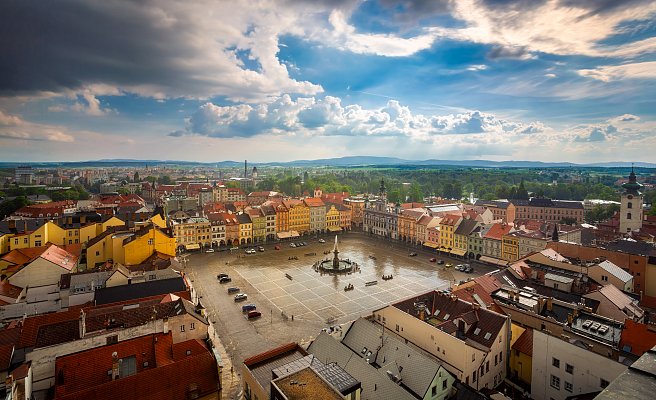
In 1251, Přemysl Otakar II decided to establish a centre of royal power and he laid out a rectangular city plan (with a central square of 133 m) at an important ford. The town was actually
founded in 1265 and was very quickly settled by traders and craftsmen who formed the core of the prosperous town. The Black Tower with 225 stairs, the Cathedral of St. Nicholas and many Renaissance and Baroque houses with arcades, passages and narrow streets heading in all directions are located in the area near the square with the Samson Fountain located on it. The Masné krámy Restaurant, which was renovated in 2007 and which still has the ancient butcher’s stations, is also located nearby.
The first horse-drawn railway was built connecting České Budějovice to Linz., The Hardtmuth entrepreneurs founded a pencil factory in Vienna at the end of the 18th century and subsequently moved it to České Budějovice. Its products are now exported all over the world.
The Budějovický Budvar Brewery was founded in 1895, even though the tradition of beer brewing dates back to the 13th century. Some world-famous restaurants (such as the Schweizerhaus in Vienna) buy Budějovický Budvar exclusively.
Modern architecture is represented by a functionalist villa located near the Long Bridge, which was built by Miroslav Zátka, an entrepreneur. The town’s centre is intersected by Na Sadech Avenue where visitors can appreciate the sculptural group called Humanoids, which beautifies the beginning of Lanna Avenue leading to the railway station. Lanna‘s shipyard was opened in the town’s centre in 2011 and this completed the first stage of making the Vltava River navigable between České Budějovice and Hluboká nad Vltavou and on to Týn nad Vltavou.
Did you know that...
there used to be a medieval pillory for punishing dishonest craftsmen on the site where Samson Fountain now stands?
Natives and notables
- Přemysl Otakar II (about 1233–1278) – the Czech king called “the Iron and Golden King,” the founder of the town, the most powerfulruler in Europe at the time; he died in the Battle of the Marchfeld.
- Vojtěch Lanna (1805–1866) – an entrepreneur, industrialist and builder; he was a major shareholder in the České Budějovice – Linz horse-drawn railway, whose operation was leased to him from 1835–1846. He traded in the timber industry, participated in the development of Kladno coalmines and realized a number of water and railway construction projects. He is a co-founder of the Academy of Arts, Architecture and Design in Prague.
Our tip
A cultural city also has important cultural institutions. České Budějovice is the seat of the South Bohemian Theatre, which has four
ensembles: drama, opera, ballet and the Small Theatre. Individual ensembles also perform in other parts of the region; for instance the Revolving Auditorium at Český Krumlov falls under this theatre. The city is also home to the South Bohemian Chamber Philharmonic Orchestra, with its newly remodelled concert hall.